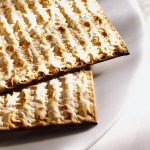“Now the Feast of Unleavened Bread, which is called the Passover, was approaching. And when He (Jesus) had taken some bread and given thanks, He broke it, and gave it to them, saying, ‘This is My body which is given for you.'” (Luke 22:1, 19)
My family and I went to a Seder (Passover) dinner at our church. (Video is of kids dancing at the conclusion.)
A “Seder” is “a ceremonial dinner that commemorates the Exodus from Egypt and includes the reading of the Haggadah and the eating of symbolic foods.” (dictionary.com)
It was a Seder dinner that Jesus celebrated with His disciples that we often refer to as “The Last Supper.”
And it’s just so amazing the symbolism of a Seder.
And when you realize Christ Himself (of whom the entire Seder speaks and was pointing to for thousands of years) finally shows up and celebrates/fulfills it. Wow!
Included in the ceremony of the Seder is the partaking of the matzo (unleavened) bread and the hiding of the same (called the “Afikomen”).
This bread is a picture of Jesus Christ in the following ways…
1. The matzo bread is unleavened.
In Scripture, leaven symbolizes sin. (1 Corinthians 5:7) And so we have the sinlessness of the Savior represented. (Hebrews 4:15)
2. The matzo bread is striped and pierced. (Isaiah 53:5; Zechariah 12:10)
And so we have the scourging by Pilate and the piercing by a Roman soldier of Christ’s side represented. (John 19:1, 34)
3. The matzo bread is broken.
From maranathalife.com: “As part of the Passover meal, there is a plate with three unbroken matzos on it. During the course of the celebration, these are stacked up and placed into a white linen bag, kind of like an envelope. Then the middle one is withdrawn, the other two being set aside. These three represent the Father, the Son, and the Holy Spirit. Of the three, only the Son is brought out where man may look upon Him. This middle matzo is broken in half. Jesus too, was broken for us.”
4. The matzo bread is hidden and found. (John 19:38-42; 20:1-8)
From maranathalife.com: “Of the broken matzo, half is wrapped in a linen napkin. This is called the afikomen. Well, after Jesus had died, Joseph of Arimathaea came and asked Pilate for His body. Then ‘he took the body, and wrapped it in a clean linen cloth’ (Mt 27:59). Sometime during the meal, the father, who is the leader of the Passover celebration, takes the afikomen and hides it. This is symbolic of Joseph who took Jesus body, ‘and laid it in his own new tomb, which he had hewn out in the rock: and he rolled a great stone to the door of the sepulchre, and departed’ (Mt 27:60). However, it doesn’t stay hidden. At the end of the meal, all the children (12 and under) are sent in search of the afikomen. Whoever finds it, brings it to the father, who unwraps it. He holds it up, so all can see, and says ‘the afikomen has been found.'”
And so we have the burial of Jesus and His resurrection depicted. He is risen indeed!




